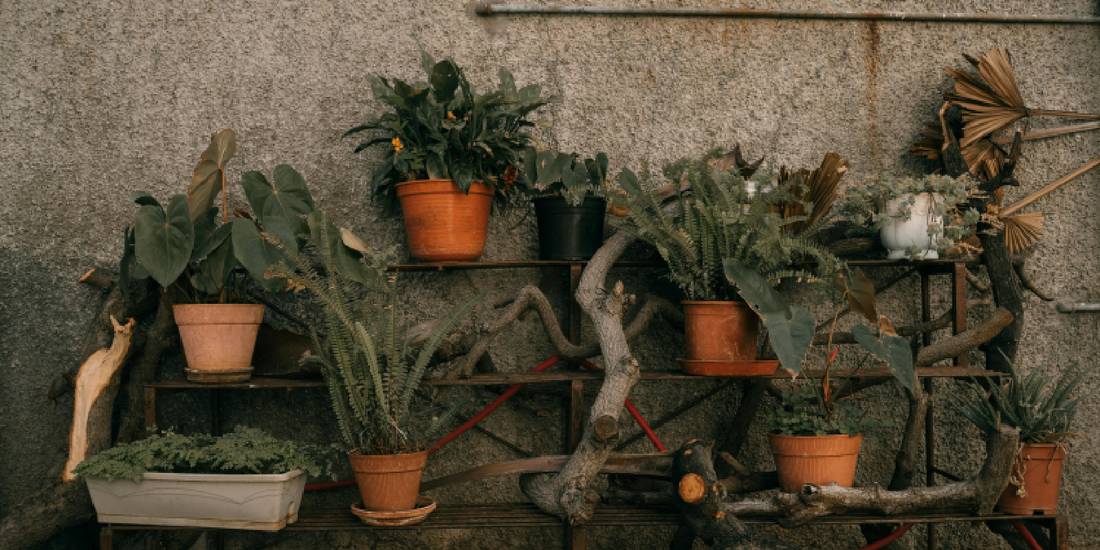
Creating balanced asymmetrical green spaces
Share
In interior design, the idea of balance has often been associated with symmetry: two identical chairs facing each other, perfectly centered wall art, or matching planters aligned in pairs. Yet nature itself does not follow such rigid order. Forests, rivers, mountains, and gardens thrive in asymmetry, where irregularity creates visual rhythm and organic harmony. Translating this principle indoors can transform any space into a dynamic sanctuary.
This is where asymmetrical green spaces enter the conversation. Instead of forcing plants into rigid patterns, we allow them to breathe, cascade, and stretch in different directions, creating a sense of movement and natural balance. At amoyls, our philosophy is to merge functionality with artistry. The VerdantGlow S-Shaped 8-Tier Plant Shelf with Grow Lights is more than furniture—it is an invitation to design with asymmetry. Its unique shape, integrated grow lights, and eight versatile tiers create the perfect foundation for those who want to curate modern, living green art at home.
The Beauty of Asymmetry in Design
A Historical Perspective
The concept of asymmetry has roots in Japanese aesthetics, particularly the principle of wabi-sabi, which celebrates imperfection and transience. Unlike Western classical design, which often prioritizes balance through mirroring, wabi-sabi values incomplete forms, irregular patterns, and the subtle elegance of asymmetry.
Modern interior design has embraced these ideas, blending them with minimalism, biophilic design, and contemporary art. This shift highlights the truth that perfection is not found in rigid sameness, but in the irregularities that create character and depth.
Psychological Benefits
Studies in environmental psychology suggest that asymmetrical arrangements stimulate curiosity and keep the mind engaged. While symmetry feels orderly, asymmetry feels alive. A space arranged with balanced irregularity encourages exploration, reduces stress, and connects us to the patterns of nature.
Balance Without Mirrors
The key to asymmetry is balance without duplication. A tall plant on one side may be balanced by two smaller plants on the other. A cascading vine on the left tier may be offset by a bold-leaf species placed higher up on the right. This dynamic arrangement is not chaotic—it is thoughtfully unbalanced, creating flow and cohesion.
The Role of VerdantGlow in Asymmetrical Spaces
The VerdantGlow S-Shaped 8-Tier Plant Shelf with Grow Lights is designed to be a tool for creativity. Its distinctive S-curve naturally breaks from rigid linear shelving, offering both structure and freedom.
Key design features include:
- Eight levels of display: Each tier offers a unique height and depth, perfect for layering plants of varying sizes.
- S-shaped silhouette: The curve adds sculptural elegance, encouraging irregular placements that still feel intentional.
- Built-in grow lights: These ensure plants receive even illumination, preventing uneven growth that often plagues asymmetrical arrangements.
- Compact footprint: Its vertical design fits neatly into corners while still allowing expansive displays.
- Durability & sustainability: Crafted for long-term use, with energy-efficient lighting that supports plant health.
The shelf acts as both an organizer and an artistic framework. Instead of arranging plants in rows, you’re encouraged to experiment—stacking, staggering, and cascading them in creative ways.
Techniques for Creating Balanced Asymmetry
1. Play with Plant Heights
The quickest way to establish asymmetry is through vertical variation.
- Top tiers: Use tall, slender plants like snake plants or dracaenas.
- Mid tiers: Fill with medium-sized foliage like calatheas, monstera, or ZZ plants.
- Lower tiers: Allow cascading vines—pothos, ivy, or string of pearls—to spill downward, drawing the eye in diagonal flows.
2. Contrast Leaf Shapes
Mixing textures adds richness:
- Broad leaves (monstera) balanced with feathery ferns.
- Succulents paired with vining plants.
- Variegated leaves alongside solid dark greens.
3. Use Color Strategically
Color asymmetry can be subtle yet powerful. Place a brightly colored bromeliad or flowering plant on one side, balanced by darker green foliage on the other. Even differences in leaf shades—from emerald to deep jade—add depth.
4. Respect Negative Space
Not every tier must be filled. Leaving some shelves intentionally empty creates breathing room, allowing other plants to stand out more vividly. This balance between presence and absence is central to good asymmetry.
5. Rotate Angles
Instead of aligning all pots neatly, rotate them slightly outward or inward. A small change in direction creates visual movement, preventing the layout from feeling static.
How Grow Lights Support Asymmetrical Design
One challenge with asymmetry is uneven light distribution. Plants placed off-center or at varying heights may not all receive equal sunlight. The VerdantGlow Shelf addresses this problem through integrated grow lights.
- Even illumination: Each level is bathed in the right spectrum, ensuring all plants grow uniformly.
- Extended daylight hours: Perfect for rooms with limited natural light or urban apartments.
- Supports variety: From low-light ferns to light-hungry succulents, all species thrive together.
Asymmetry in placement does not mean inequality in care. Every plant remains healthy, no matter where it sits on the shelf.
Styling Ideas for Every Room
Living Room Corners
Anchor the top with a tall statement plant like a fiddle-leaf fig, balance the middle tiers with trailing pothos, and add a splash of color with flowering species near eye level.
Home Office Inspiration
Use air-purifying plants like peace lilies and snake plants to reduce toxins. Pair them asymmetrically with small succulents to create energy without cluttering your desk view.
Bedroom Retreat
Soft-leaved plants such as ferns and calatheas create a soothing vibe. Place trailing vines closer to the bed for a natural canopy effect. Leave one or two tiers empty to avoid visual noise.
Balcony or Entryway
Create an asymmetrical statement with hardy outdoor plants—succulents, dwarf palms, or colorful coleus. This design creates a welcoming yet modern first impression.
Plant Combinations That Work Well
- Tropical Jungle: Monstera, bird of paradise, trailing philodendrons.
- Desert Contrast: Tall cacti, small succulents, aloe vera, cascading string of bananas.
- Minimalist Green: Snake plants, ZZ plants, and a few trailing ivies.
- Colorful Mix: Calathea, coleus, and bromeliads offset by classic green foliage.
Each combination highlights different moods while maintaining asymmetrical rhythm.
Case Study: A Small Apartment Transformation
Consider a 600-square-foot apartment in an urban center. The living room had limited natural light and minimal floor space. Using the VerdantGlow shelf in the corner, the owner layered:
- A tall snake plant on the top tier,
- Trailing pothos cascading halfway down,
- A colorful bromeliad at eye level,
- Small succulents on the bottom tiers.
The result was a lush vertical display that drew the eye upward, creating the illusion of more space. The asymmetry made the apartment feel less boxy and more dynamic, while the grow lights ensured healthy growth year-round.
Balancing Asymmetry with Decor
The shelf is most effective when integrated into a broader design theme. Pair it with:
- Abstract wall art that uses irregular forms.
- Asymmetrical rugs with shifting patterns.
- Offset lighting like angled floor lamps.
Together, these elements create a cohesive design language where asymmetry is celebrated across the room.
Sustainability and Practical Benefits
- Durability: Metal frame and high-quality finish ensure longevity.
- Efficiency: Built-in LED grow lights save energy.
- Space-saving: One shelf accommodates dozens of plants, reducing the need for multiple stands.
- Eco-conscious design: Encourages vertical greenery, which improves indoor air quality and reduces clutter.
Frequently Asked Questions (SEO Section)
1. Can asymmetry look messy instead of stylish?
Only if balance is ignored. The key is intentional placement—varying height, shape, and space while maintaining overall harmony.
2. How many plants fit on the VerdantGlow shelf?
It comfortably supports 8–12 medium pots, with room for trailing species.
3. Do grow lights really make a difference?
Yes. They provide consistent light, ensuring that asymmetrically placed plants thrive even in low-light rooms.
4. Is this shelf only for modern interiors?
Not at all. Its sleek design complements minimal, bohemian, rustic, and eclectic spaces.
5. What plants are best for asymmetrical design?
Mix tall structural plants (snake plant, dracaena) with cascading vines (pothos, ivy) and fillers like succulents.
Final Thoughts
Creating balanced asymmetrical green spaces is about celebrating the irregular beauty of nature indoors. With the amoyls VerdantGlow S-Shaped 8-Tier Plant Shelf with Grow Lights, homeowners have the perfect tool to experiment. It brings structure without rigidity, balance without duplication, and artistry without effort.
Asymmetry is not chaos—it is nature’s rhythm. By embracing it, your living space becomes more dynamic, inviting, and authentically alive.
